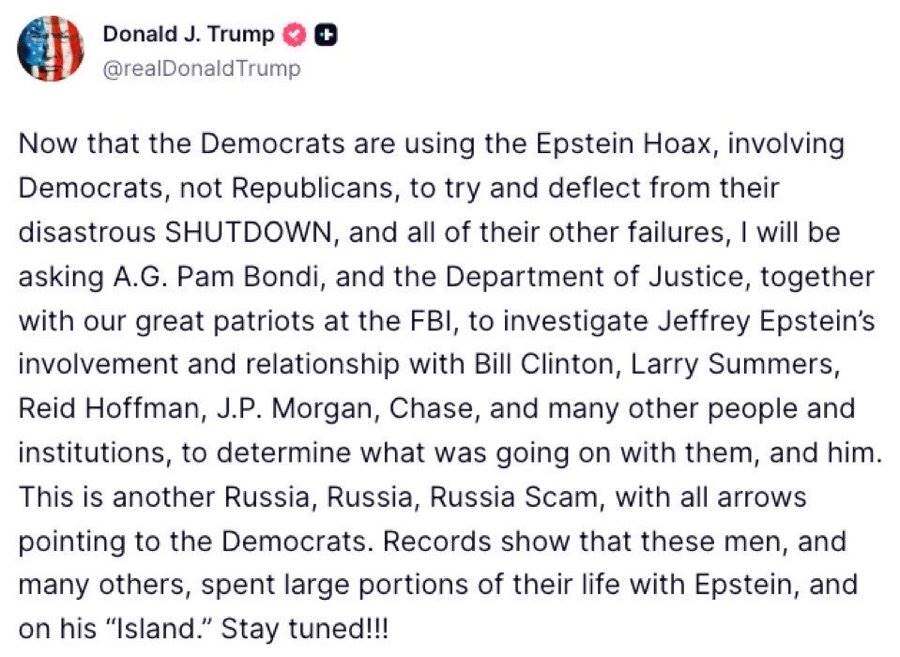Trump's clash with JPMorgan Chase has dragged Bitcoin and MSTR into the fray.
Original author: MarylandHODL (BitBonds = StructuralInnovation)
Original article translated by: Deep Tide TechFlow
The covert battle for monetary power: a direct confrontation between the old order and the new architecture
A struggle for monetary power is unfolding before our eyes—but almost no one truly understands the stakes involved. Here is my highly speculative interpretation of this phenomenon.

——@FoundInBlocks
Over the past few months, a pattern has gradually emerged in politics, markets, and the media. Scattered news headlines have suddenly begun to connect, market anomalies no longer appear accidental, and institutional behavior has become unusually aggressive. Beneath the surface, there seems to be a deeper event brewing.
This is not a typical currency cycle fluctuation.
This is not a partisan conflict in the traditional sense.
This is not what is known as "market volatility".
What we are witnessing is a direct confrontation between two opposing monetary systems:
The old order... was centered around JPMorgan, Wall Street, and the Federal Reserve.
The new order... centers on the Treasury, stablecoins, and a digital architecture based on Bitcoin.
This conflict is no longer a theoretical debate. It is real, it is accelerating, and it has come into the public eye for the first time in decades.
The following attempts to depict the real battlefield... a battlefield that most analysts cannot see because they are still interpreting a world that is breaking free of its own constraints using a framework from 1970 to 2010.
JPMorgan Chase emerges from the shadows
Most people think of JPMorgan Chase as just a bank. This is a misconception.
JPMorgan Chase is the operating arm of the global financial system... It is the entity closest to the core mechanisms of the Federal Reserve, influencing dollar settlements worldwide, and is also a major implementer of the traditional monetary architecture .
Therefore, when Trump posted about the Epstein network and explicitly mentioned JPMorgan Chase (rather than referring to any specific individuals), it wasn't a rhetorical exaggeration. He directly brought the most central institution of the system into the narrative.

at the same time:
- JPMorgan Chase is a major driver of aggressive short selling pressure on Strategy (MSTR), and this is happening at a critical moment when Bitcoin's macro narrative threatens the interests of traditional currencies.
- When clients attempted to transfer their Strategy shares out of JPMorgan Chase, reports indicated settlement delays, suggesting custody pressures… This phenomenon typically only occurs when internal operations are under significant stress.
(Source: https://x.com/EMPD_BTC/status/1991886467694776531?s=20)
JPMorgan Chase is strategically at the heart of the Federal Reserve ecosystem, both structurally and politically. Weakening its position would be tantamount to weakening the entire old monetary system itself.
None of this is normal.
And all of this is part of the same story.
The government's silent shift: returning monetary power to the treasury
While the media focuses on superficial topics such as culture wars, the real strategic agenda revolves around currency.
The government is quietly working to bring the core power of currency issuance back to the U.S. Treasury… through the following methods:
- Treasury-integrated stablecoins
- Programmable settlement rails
- Using Bitcoin reserves as long-duration collateral
This transformation is not a minor adjustment to the existing system, but a direct replacement of the system's core power center.
Currently, the Federal Reserve (Fed) and commercial banks (led by JPMorgan Chase) virtually monopolize the creation and distribution of all US dollars. If the Treasury and stablecoins become the central hub for issuance and settlement, the banking system will lose its authority, profits, and control.
JPMorgan Chase is well aware of this.
They fully understand the true meaning of stablecoins.
They also understand what will happen if the Treasury becomes the issuer of programmable dollars.
Therefore, they launched a counterattack... not through press conferences, but through market mechanisms:
- Derivatives pressure
- Liquidity bottleneck
- Narrative suppression
- Hosting delay
- and political influence
This is not a policy debate, but a struggle for survival.
Bitcoin: An Unexpected Battlefield
Bitcoin is not the target of the attack... it is the terrain of the battle.
The government hopes to quietly and strategically accumulate resources before taking any concrete action to advance a Treasury-led digital settlement system. Announcing the plan prematurely would trigger a gammasqueeze in the market, pushing Bitcoin into escape velocity and making the accumulation cost prohibitive and uncontrollable.
The problem is that the old system is using a gold-like suppression mechanism to dampen Bitcoin's signals:
- By flooding in paper derivatives
- Massive synthetic short selling
- Perception warfare
- Liquidity raids at key technical levels.
- Creating custodialbottlenecks at major primary brokers.
JPMorgan Chase has mastered these techniques in the gold market for years, and now they are being applied to Bitcoin.
This is not because Bitcoin directly threatens the profits of the banking industry... but because Bitcoin strengthens the future monetary architecture of the Treasury while weakening the position of the Federal Reserve.
The government faces a difficult strategic choice:
- This allows JPMorgan Chase to continue suppressing Bitcoin, thereby maintaining its ability to accumulate at low prices.
- Making a strategic announcement to drive a Bitcoin breakthrough, but losing the opportunity for covert planning before a political consensus is reached.
This is why governments have remained publicly silent on the issue of Bitcoin.
It's not that they don't understand Bitcoin... it's that they understand it too well.
The two sides clashed on a fragile foundation.
The entire context of this struggle is built upon a monetary system that is over sixty years old, and the characteristics of this system include:
- Financialization
- Structural leverage
- Artificially lowering interest rates
- Asset-first growth model
- Reserve concentration
- And institutional cartelization.
Historical correlations are collapsing everywhere because the system is no longer coherent. Traditional finance (TradFi) commentators who view this as a normal economic cycle are failing to realize that the entire cycle itself is crumbling.
This system is breaking down.
The underlying structure is no longer stable.
Motivations for profit are diverging.
Both camps (the traditional order represented by JPMorgan Chase and the emerging order promoted by the Treasury Department) are clashing on the same fragile infrastructure. Any miscalculation could trigger a chain reaction of instability.
This also explains why the current actions seem so strange, inconsistent, and urgent.
Strategy: A conversion bridge under direct attack
Now we introduce a crucial aspect that most commentators overlook.
Strategy (MSTR) is more than just another company holding Bitcoin. It has become a transformation mechanism—a bridge connecting traditional institutional capital with the emerging Bitcoin-treasury monetary architecture.
MSTR's structure, its leveraged Bitcoin strategy, and its preferred stock offerings effectively transform fiat currency, credit, and fiscal assets into long-term Bitcoin exposure. In doing so, MSTR has become a de facto entry point for institutional and retail investors who cannot (or are unwilling) hold spot Bitcoin directly, while also providing them with an opportunity to escape the suppressed yields under yield curve control (YCC).
This means:
If the government envisions a future where a Treasury-backed digital dollar coexists with Bitcoin reserves, then MSTR is the key corporate channel to achieve this transition.
JPMorgan Chase is well aware of this.
Therefore, when JPMorgan Chase:
- This led to large-scale short selling.
- Manufacturing and delivery delays
- Pressure on MSTR's liquidity
- When it fuels negative market narratives, it doesn't just attack Michael Saylor (founder of Strategy). It attacks the very bridge that makes long-term government strategies viable.
There is even a possible scenario (though still highly speculative, it is becoming increasingly logical) in which the US government may eventually intervene and make a strategic investment in MSTR. As recently suggested by ( @joshmandell6 ), this intervention could take the following forms:
- By injecting US Treasury bonds in exchange for ownership of MSTR,
- This would explicitly support MSTR's preferred stock instruments and improve its credit rating.
Such a move will bring political and financial risks, but it will also send an undeniable signal to the world: the United States is defending a key node in its emerging currency architecture.
This possibility alone is enough to explain the intensity of JPMorgan Chase's attack on MSTR.
A critical window: Control of the Federal Reserve Board
The timeline becomes urgent here.
As @caitlinlong recently pointed out, Trump needs to effectively control the Federal Reserve before Jerome Powell leaves office. However, the current situation is unfavorable for him... He is trailing the board by about three to four votes.
Multiple key nodes are converging simultaneously:
- Lisa Cook's Supreme Court challenge could drag on for months, delaying key reforms.
- The Federal Reserve Board vote in February 2025 could solidify a hostile governance structure over the next few years.
- A poor performance by the Republicans in the upcoming midterm elections would weaken the government's ability to readjust monetary power.
That's why current economic momentum is crucial, rather than waiting six months to act.
This is why the Ministry of Finance's issuance strategy has changed.
This is why stablecoin regulation has suddenly become crucial.
This is why Bitcoin price suppression is meaningful.
This is why the struggle surrounding MSTR is not a trivial matter, but a structural problem.
If the government loses the support of Congress, Trump will become a "lame duck" president... unable to reshape the monetary system and instead trapped by the very institutions he tries to circumvent. And by 2028, this window will be completely closed.
The urgency of time is real, and the pressure is immense.
A broader strategic landscape
When you step back and look at the big picture, this pattern becomes crystal clear:
- JPMorgan Chase is waging a defensive battle in an attempt to maintain its global dominance centered on the Federal Reserve-banking system.
- The government is carrying out a covert transformation, returning monetary control to the Treasury through stablecoins and Bitcoin reserves.
- Bitcoin has become a proxy battleground, its price is suppressed to protect the old system, while the hidden accumulation is empowering the new system.
- Strategy (MSTR) is a bridge for transformation and an institutional entry point that threatens JPMorgan Chase's control over capital flows.
- The governance of the Federal Reserve is a key bottleneck, while political timing is the biggest limiting factor.
All of this is happening on an unstable foundation, where any misstep could trigger unpredictable systemic consequences.
This is not just a financial story, nor is it just a political story.
This is a monetary transformation on a civilizational scale. And for the first time in sixty years, this conflict is no longer hidden behind the scenes.
Trump's bet
The government's strategy is gradually becoming clear:
- This allowed JPMorgan Chase to overdo it with price suppression.
- Quietly accumulating Bitcoin.
- Protect and potentially further strengthen the Strategy (MSTR) as a transformation bridge.
- To rapidly drive the reshaping of the Federal Reserve's governance structure.
- The Treasury Department is positioned as the issuer of the digital dollar.
- We await the right geopolitical moment (possibly the Mar-a-Lago Agreement) to announce this new framework.
This is not a mild reform, but a complete overthrow of the monetary order of 1913... Monetary power will return from financial institutions to political institutions.
If this gamble succeeds, the United States will enter a completely new monetary era, based on transparency, digital tracks, and a hybrid Bitcoin collateral framework.
If it fails, the old system will further strengthen its control, and the window for change may not open again for the next generation.
Regardless of the outcome, the war has begun.
Bitcoin is no longer just an asset... it has become a fault line between two competing futures.
However, what neither side realized was that they would ultimately lose to absolute scarcity and mathematical truth.
During the struggle for control between these two behemoths, please be prepared for unexpected events and pay attention to safety.
- 核心观点:新旧货币体系正激烈交锋。
- 关键要素:
- 摩根大通打压比特币与MSTR。
- 政府推动财政部主导稳定币。
- 比特币成为双方争夺焦点。
- 市场影响:或引发系统性金融波动。
- 时效性标注:中期影响



